Exercises (3162)
Raising and lowering the pelvis in the shoulder position (hip extension) ► hip thrust
Power
Individual work
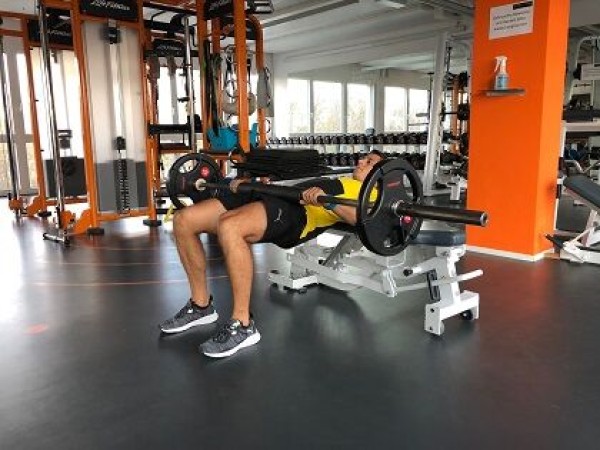
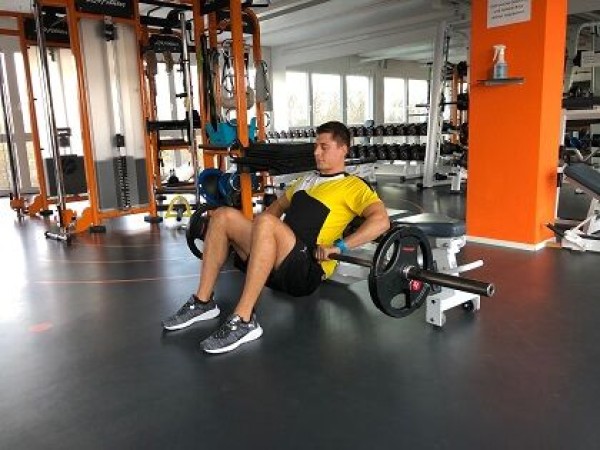
Lying on your back, rest your shoulders on the (flat) bench, keep your hips in the air with your legs bent, place the barbell on your hips and hold it with your hands in an overhand grip, lower your buttocks in this position and press back down firmly to the starting position.
Starting position:
- Lie on your back on the flat bench (only place your shoulders on the bench)
- Legs bent, feet on the floor
- Hips in the air (buttocks pressed upwards - a line from head to knee), barbell on the hips
- Head in line with the back (slight double chin)
Finishing position:
- Buttocks lowered
Attention:
Always keep your head in line with your back (slight double chin) and your core muscles under tension.
1 flat bench/swinging box
1 barbell
Raising and lowering the pelvis in shoulder position (hip extension) one-legged (left) ► hip thrust 1-leg
Power
Individual work
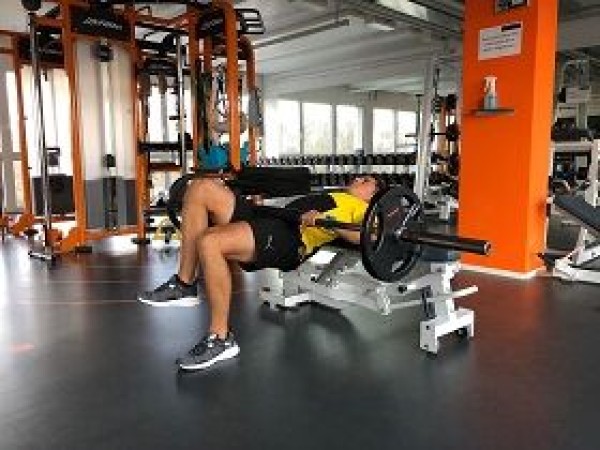
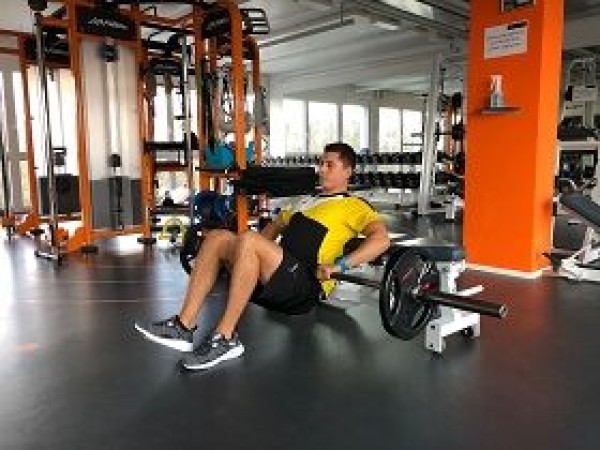
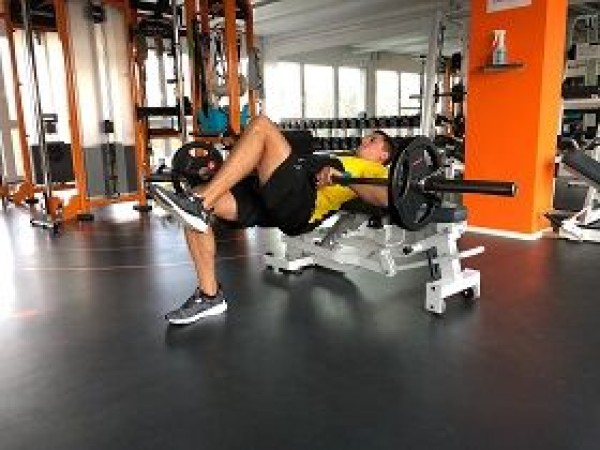
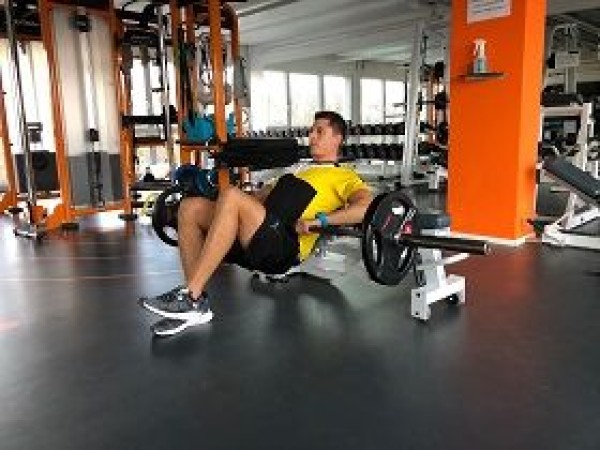
Lying on your back, rest your shoulders on the (flat) bench, keep your hips in the air with one leg bent on the floor (left) and one leg raised (right), place the barbell on your hips and hold it with your hands in an overhand grip, lower your buttocks in this position and press firmly back to the starting position.
Starting position:
- Lying on your back on the flat bench (only place your shoulders on the bench)
- One leg bent on the floor, one leg held high
- Hips in the air (buttocks pressed upwards - a line from head to knee), barbell on the hips
- Head in line with the back (slight double chin)
Finishing position:
- Buttocks lowered
Attention:
Always keep your head in line with your back (slight double chin) and your core muscles under tension.
1 flat bench/swinging box
1 barbell
Raising and lowering the pelvis in shoulder position (hip extension) one-legged (right) ► hip thrust 1-leg
Power
Individual work

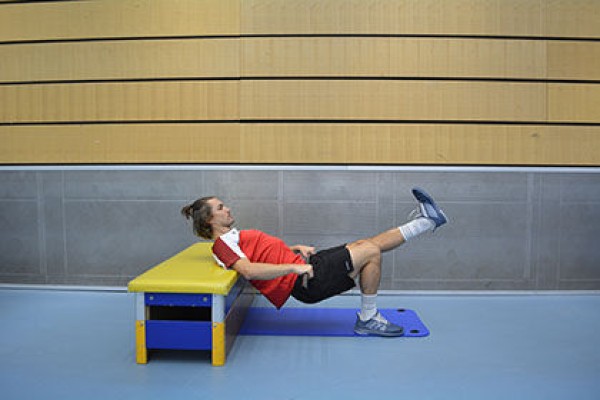
Lying on your back, rest your shoulders on the (flat) bench, keep your hips in the air with one leg bent on the floor (right) and one leg raised (left), place the barbell on your hips and hold it with your hands in an overhand grip, lower your buttocks in this position and press firmly back to the starting position.
Starting position:
- Lying on your back on the flat bench (only place your shoulders on the bench)
- One leg bent on the floor, one leg held high
- Hips in the air (buttocks pressed upwards - a line from head to knee), barbell on the hips
- Head in line with the back (slight double chin)
Finishing position:
- Buttocks lowered
Attention:
Always keep your head in line with your back (slight double chin) and your core muscles under tension.
1 flat bench/swinging box
1 barbell
Raising and lowering the pelvis in the shoulder position ► hip thrust
Power
Individual work

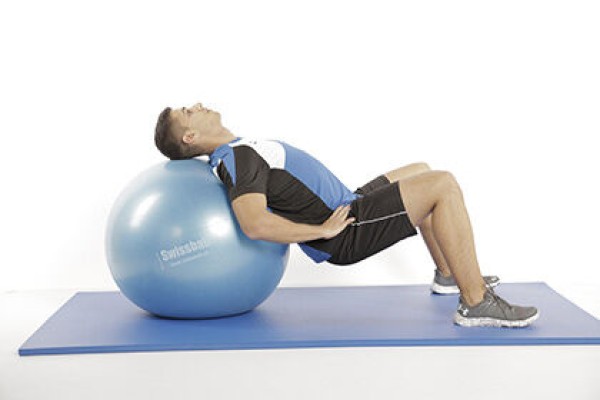
Shoulders and head rest on the exercise ball, legs bent, feet flat on the floor, arms stretched out and held high, buttocks raised and lowered.
Lighten:
Arms crossed on the chest or supported on the hips, just hold the position with the pelvis raised (without raising and lowering the buttocks).
Harden:
Additional weight (on the hips); unstable support for the legs.
1 exercise ball
1 weight disc/dumbbell/sandbag ► to make the exercise more difficult (additional weight)
1 ball/balance board/balance cushion ► to make the exercise more difficult (unstable surface)
Alternating raising and lowering of the pelvis in the shoulder position (hip bridge/pelvic lift) ► glute bridge
Power
Individual work
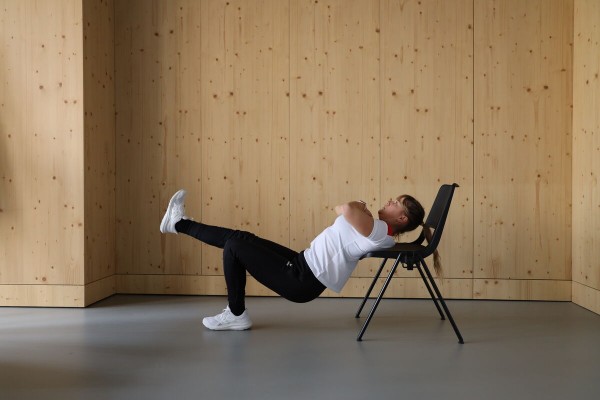
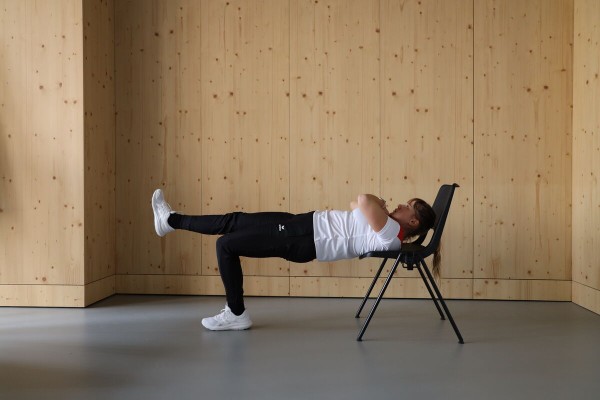

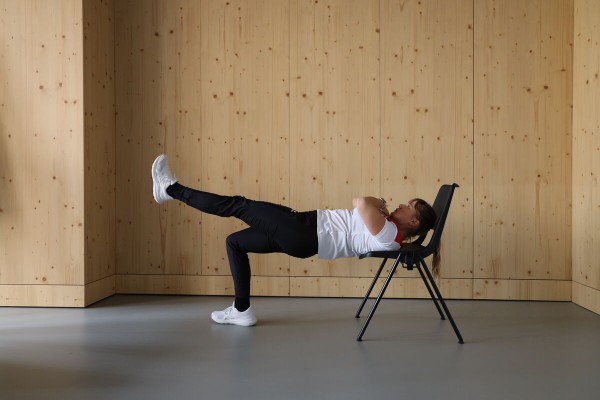
Position your shoulders with your upper back on the edge of the seat of the chair, your legs bent with your feet on the floor (heel below the knee) and your arms crossed over your chest. From this position, lift one leg and stretch it out approximately horizontally to the floor (the thighs of the legs are parallel to each other), now lower the pelvis and raise it again. Finally, return the free leg to the starting position (put your foot down). Switch sides after each exercise.
Attention:
The upper body and thighs practically form a line in the starting position, keep the pelvis parallel to the floor (do not let it hang sideways).
1 (office) chair (without castors)
Raising and lowering the pelvis in the shoulder position on one leg (left) (hip bridge/pelvic lift) ► glute bridge
Power
Partner work

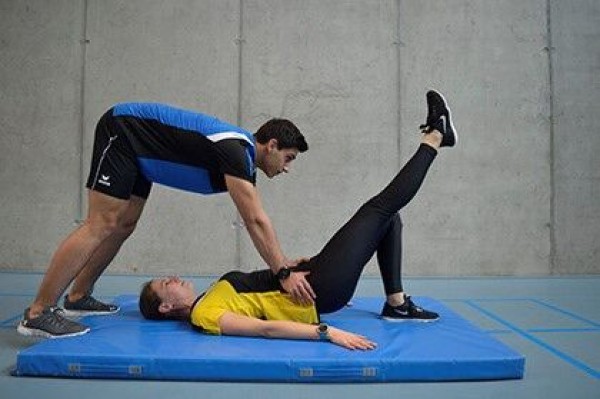
Trainee: Supine position, one leg bent and raised on the floor, the other (right) leg stretched out and raised, arms at the side of the body, raise and lower the pelvis (do not lower the buttocks).
Partner: Support yourself on the hips of the active participant.
Attention:
Always listen to/respond to your partner (adjust pressure/resistance). No hollow back, push knees apart.
Lighten:
Just hold the position (without raising and lowering the pelvis), more upright stance of the partner (less pressure/resistance).
Harden:
Position the partner more forward (additional pressure/resistance); unstable base for the supporting leg.
1 ball/balance cushion/balance board ► Make the exercise more difficult (unstable surface)
Raising and lowering the pelvis in the shoulder position on one leg (left) (hip bridge/pelvic lift) ► glute bridge
Power
Individual work


Shoulder position, one leg (left) bent and placed on the floor (heel below the knee), the other (right) leg stretched out, the thighs of the legs are parallel to each other, arms flat on the floor at the sides of the body, raise and lower the pelvis.
Attention:
Upper body only rests on the shoulders/do not lower the upper body completely, keep the pelvis parallel to the floor (do not let it hang sideways).
Lighten:
Lift the pelvis less; just hold the position.
Harden:
Additional weight (on the hips); unstable support for the leg.
Variation:
Place one leg over the other (instead of stretching out).
1 weight cuff/weight vest/weight disc/dumbbell/sandbag ► to make the exercise more difficult (additional weight)
1 ball/balance cushion/balance board ► to make the exercise more difficult (unstable surface)
Raising and lowering the pelvis in the shoulder position on one leg (left) (hip bridge/pelvic lift) ► glute bridge
Power
Individual work


Shoulder position, one leg (left) bent and placed on the medicine ball/helmet/balance cushion/hemisphere (heel below the knee), the other (right) leg stretched out or bent and held high, arms flat on the floor at the side of the body, raise and lower the pelvis.
Attention:
Upper body only rests on the shoulders/do not lower the upper body completely, keep the pelvis parallel to the floor (do not let it hang sideways).
Lighten:
Lift the pelvis less; only hold the position; perform the exercise without a medicine ball/helmet.
Harden:
Additional weight (on the hips).
Variant:
Place one leg over the other (instead of stretching out/bending).
1 (medicine) ball/helmet
1 weight cuff/weight vest/weight disc/sandbag ► to make the exercise more difficult (additional weight)
1 balance hemisphere ► to make the exercise more difficult (unstable base)
Raising and lowering the pelvis in the shoulder position on one leg (left) (hip bridge/pelvic lift) ► glute bridge
Power
Individual work
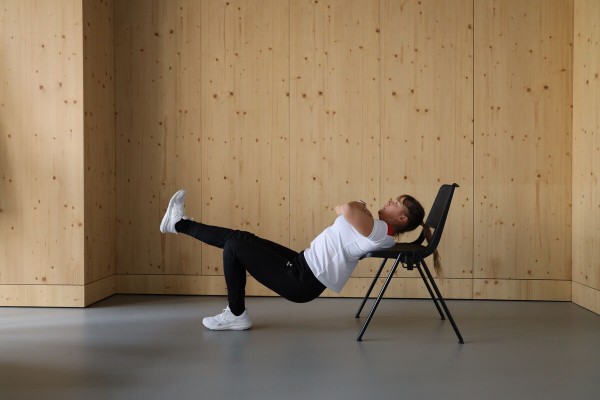
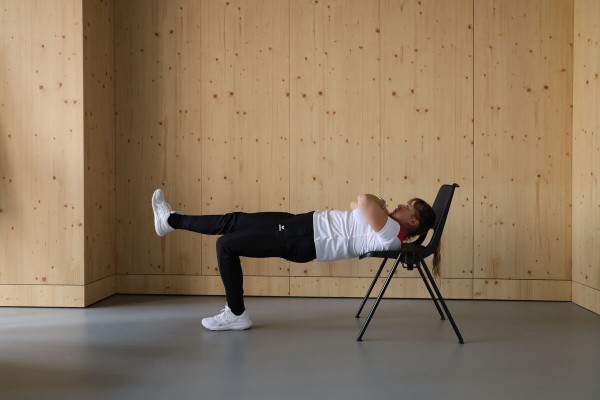
Shoulder position with the upper back on the edge of the seat of the chair, one leg (left) bent and placed on the floor (heel below the knee), the other (right) leg lifted and stretched out approximately horizontally to the floor, the thighs of the legs are parallel to each other, the arms crossed on the chest. From this position, lower the pelvis and raise it back to the starting position.
Attention:
The upper body and thighs practically form a line in the starting position, keep the pelvis parallel to the floor (do not let it hang sideways).
1 (office) chair (without castors)
Raising and lowering the pelvis in the shoulder position on one leg (right) (hip bridge/pelvic lift) ► glute bridge
Power
Partner work


Trainee: Supine position, one leg bent and raised on the floor, the other (left) leg stretched out and raised, arms at the side of the body, raise and lower the pelvis (do not lower the buttocks).
Partner: Support yourself on the hips of the active participant.
Attention:
Always listen to/respond to your partner (adjust pressure/resistance). No hollow back, push the knees apart.
Lighten:
Just hold the position (without raising and lowering the pelvis), more upright position of the partner (less pressure/resistance).
Harden:
Position the partner more forward (additional pressure/resistance); unstable base for the supporting leg.
1 ball/balance cushion/balance board ► Make the exercise more difficult (unstable surface)
Raising and lowering the pelvis in the shoulder position on one leg (right) (hip bridge/pelvic lift) ► glute bridge
Power
Individual work

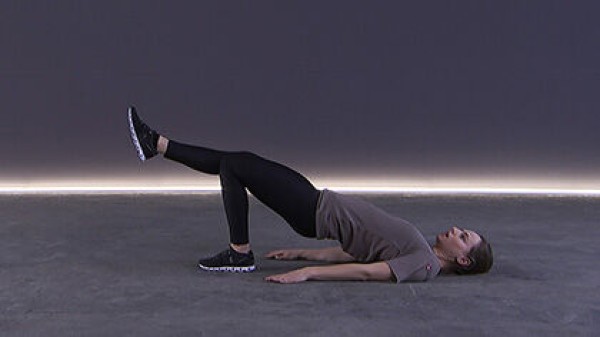
Shoulder position, one leg (right) bent and placed on the floor (heel below the knee), the other (left) leg stretched out, the thighs of the legs are parallel to each other, arms flat on the floor at the side of the body, raise and lower the pelvis.
Attention:
Upper body only rests on the shoulders/do not lower the upper body completely, keep the pelvis parallel to the floor (do not let it hang sideways).
Lighten:
Lift the pelvis less; just hold the position.
Harden:
Additional weight (on the hips); unstable support for the leg.
Variant:
Place one leg over the other (instead of stretching out).
1 weight cuff/weight vest/weight disc/dumbbell/sandbag ► to make the exercise more difficult (additional weight)
1 ball/balance cushion/balance board ► to make the exercise more difficult (unstable surface)
Raising and lowering the pelvis in the shoulder position on one leg (right) (hip bridge/pelvic lift) ► glute bridge
Power
Individual work


Shoulder position, one leg (right) bent and placed on the medicine ball/helmet/balance cushion/hemisphere (heel below the knee), the other (left) leg stretched out or bent and held high, arms flat on the floor at the side of the body, raise and lower the pelvis.
Attention:
Upper body only rests on the shoulders/do not lower the upper body completely, keep the pelvis parallel to the floor (do not let it hang sideways).
Lighten:
Lift the pelvis less; only hold the position; perform the exercise without a medicine ball/helmet.
Harden:
Additional weight (on the hips).
Variant:
Place one leg over the other (instead of stretching out/bending).
1 (medicine) ball/helmet
1 weight cuff/weight vest/weight disc/sandbag ► to make the exercise more difficult (additional weight)
1 balance hemisphere ► to make the exercise more difficult (unstable base)
Raising and lowering the pelvis in the shoulder position on one leg (right) (hip bridge/pelvic lift) ► glute bridge
Power
Individual work
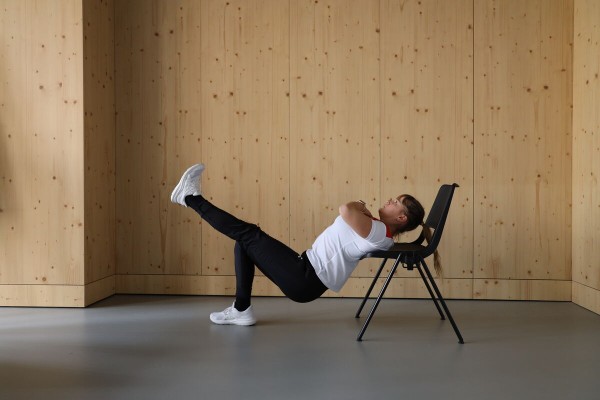
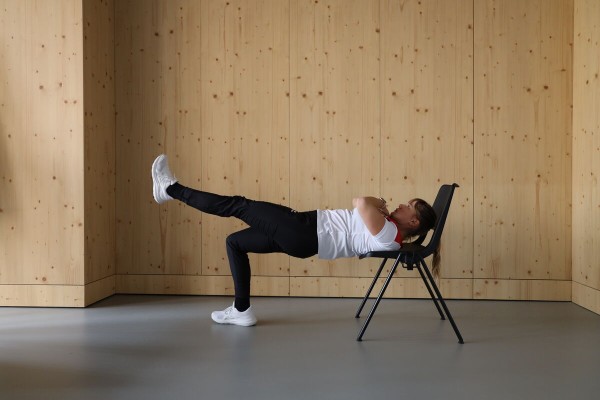
Shoulder position with the upper back on the edge of the seat of the chair, one leg (right) bent and placed on the floor (heel below the knee), the other (left) leg lifted and stretched out approximately horizontally to the floor, the thighs of the legs are parallel to each other, the arms crossed on the chest. From this position, lower the pelvis and raise it back to the starting position.
Attention:
The upper body and thighs practically form a line in the starting position, keep the pelvis parallel to the floor (do not let it hang sideways).
1 (office) chair (without castors)
Raising and lowering the leg in lateral forearm support (left) ► lateral pillar bridge adductors / side bridge
Power
Partner work
1 trainee & 1 helper ► Note change of position
(= double the time required; for lesson planner see Organisation Kraft: Info button Execution)


Trainee: Stands in side support (on the forearm), both legs are lifted off the floor, with the upper (right) leg being held by the partner, the legs are brought together and apart again (straddle position) by lowering and raising the lower (left) leg.
Partner: Stands frontally at the feet of the active participant and holds their upper foot at hip height.
Attention:
Head, torso, hips and knees practically form a line (pelvis does not tilt backwards or forwards), shoulder above the elbow, leg does not rest on the floor.
Lighten:
Just hold the position, temporarily lower your lower leg to the floor or spread it out less.
Harden:
Additional weight on the training leg (lower leg).
1 weight cuff ► Make the exercise more difficult (additional weight)
Raising and lowering the leg in lateral forearm support (right) ► lateral pillar bridge adductors / side bridge
Power
Partner work
1 trainee & 1 helper ► Note change of position
(= double the time required; for lesson planner see Organisation Kraft: Info button Execution)


Trainee: Stands in side support (on the forearm), both legs are lifted off the floor, with the upper (left) leg being held by the partner, the legs are brought together and apart again (straddle position) by lowering and raising the lower (right) leg.
Partner: Stands frontally to the feet of the active participant and holds their upper foot at hip height.
Attention:
Head, torso, hips and knees practically form a line (pelvis does not tilt backwards or forwards), shoulder above the elbow, leg does not rest on the floor.
Lighten:
Just hold the position, temporarily lower your lower leg to the floor or spread it out less.
Harden:
Additional weight on the training leg (lower leg).
1 weight cuff ► Make the exercise more difficult (additional weight)
Raising and lowering the leg in the seat (left)
Power
Individual work


Sit, arms supporting the slightly backward leaning upper body, one leg (right) bent and raised, the other leg (left) extended forwards in a high hold, raise and lower the extended training leg.
Attention:
Do not fully lower the training leg.
Lighten:
Just hold the position (leg in high hold without lifting and lowering); lift the training leg less.
Harden:
Add weight to the training leg.
Variant:
Execute circular movements with the extended leg.
1 weight cuff ► Make the exercise more difficult (additional weight)
Raising and lowering the leg in the seat (right)
Power
Individual work


Sit, arms supporting the slightly backward leaning upper body, one leg (left) bent and raised, the other leg (right) extended forwards in a high hold, raise and lower the extended training leg.
Attention:
Do not fully lower the training leg.
Lighten:
Just hold the position (leg in high hold without lifting and lowering); lift the training leg less.
Harden:
Add weight to the training leg.
Variant:
Execute circular movements with the extended leg.
1 weight cuff ► Make the exercise more difficult (additional weight)
Raising and lowering the leg in a four-footed stance (left) ► kick-back
Power
Individual work
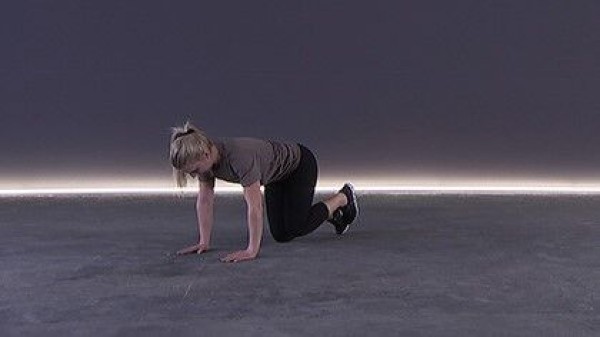

Four-foot stance (face/look down), bend one leg (left) and hold it up (right angle in the knee, lower leg perpendicular to the floor, sole of the foot pointing upwards), lower the training leg (left) (bring the knee towards the floor) and lift it back to the starting position (one-sided hip extension).
Attention:
Initiate the movement from the buttocks, pull in the abdomen, do not press into the hollow back and tense the gluteal muscles. Raise your leg to the maximum horizontal position.
Lighten:
Just hold the position with your leg raised; raise your leg less.
Harden:
Additional weight for the training leg.
1 weight cuff ► Make the exercise more difficult (additional weight)
Raising and lowering the leg in a four-footed stance (left) ► kick-back
Power
Individual work
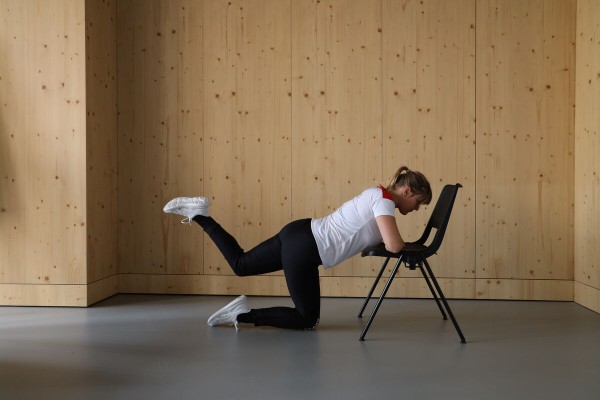
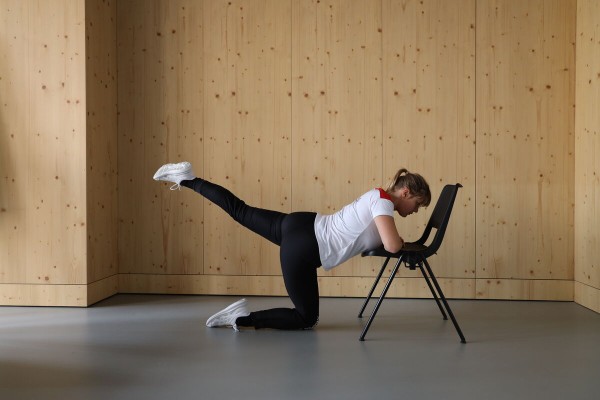
Stand on four feet (face/gaze downwards), support your upper body on the seat of the chair with your arms crossed (forearms resting on the seat cushion). Raise the free leg (left) and push it backwards. Then bend the leg again and bring the knee back to the starting position (if necessary, do not lower it completely).
Attention:
Initiate the movement from the buttocks, pull in the abdomen, do not press into the hollow back and tense the gluteal muscles.
1 (office) chair
Raising and lowering the leg in a four-footed stance (left) ► kick-back
Power
Individual work
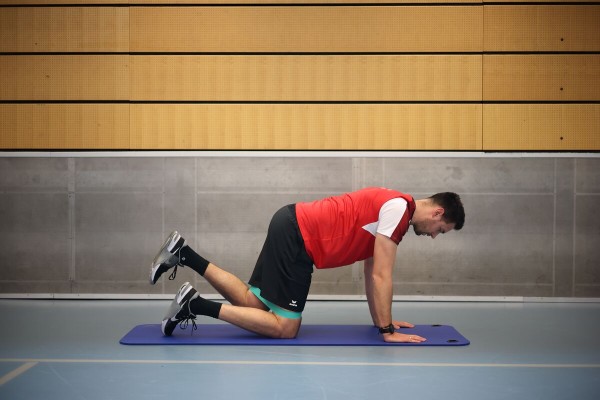
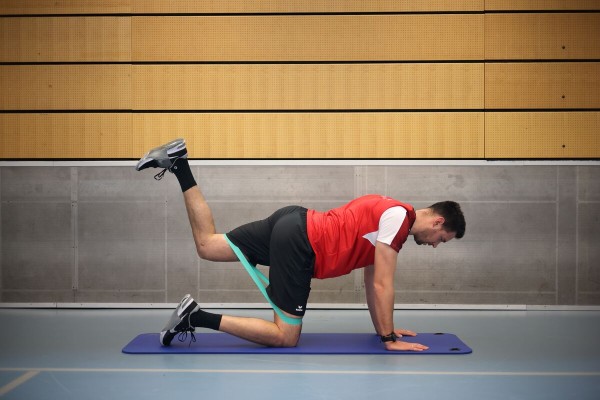
Four-foot stance (face/look down), bend one leg (left) and hold it up (right angle in the knee, thigh parallel and lower leg practically perpendicular to the floor, sole of the foot pointing upwards), lower the training leg (left) (bring the knee towards the floor) and lift it back to the starting position (one-sided hip extension).
Attention:
Initiate the movement from the buttocks, pull in the abdomen, do not press into the hollow back and tense the gluteal muscles. Raise your leg to the maximum horizontal position.
Lighten:
Choose a rubber band with less resistance.
Harden:
Choose a rubber band with greater resistance.
1 mini-band
Raising and lowering the leg in a four-footed stance (left) ► kick-back
Power
Individual work
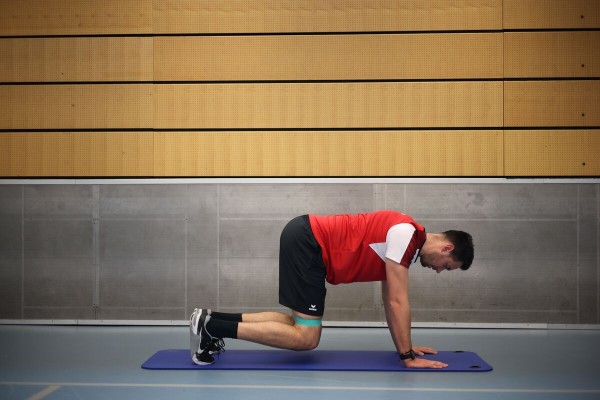
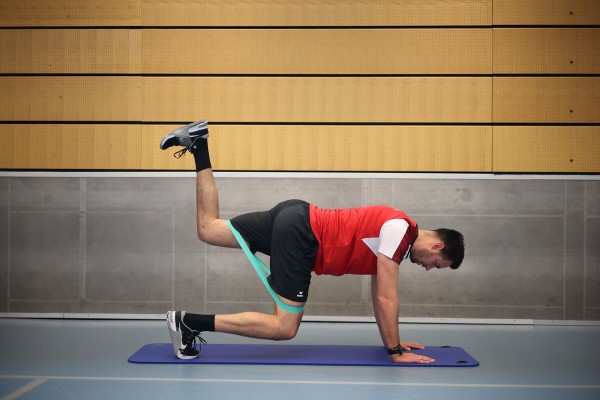
Four-foot stance (face/gaze downwards), with both legs slightly raised off the floor (right angle in the knee joint, thigh vertical and lower leg parallel to the floor, knee close to the floor), stretch an elasticated band between the legs (place the band around the thighs slightly above the knees). From this position, raise the training leg (left) (one-sided hip extension), leaving the position of the leg (angle in the knee joint) practically unchanged. In the end position, the sole of the foot points upwards, the lower leg is vertical and the thigh is parallel to the floor. Then lower the training leg back to the starting position.
Attention:
Initiate the movement from the buttocks, pull in the abdomen, do not press into a hollow back and tense the gluteal muscles. Raise your leg to the maximum horizontal position.
Lighten:
Choose a rubber band with less resistance.
Harden:
Choose a rubber band with greater resistance.
1 mini-band
Raising and lowering the leg in a four-footed stance (right) ► kick-back
Power
Individual work
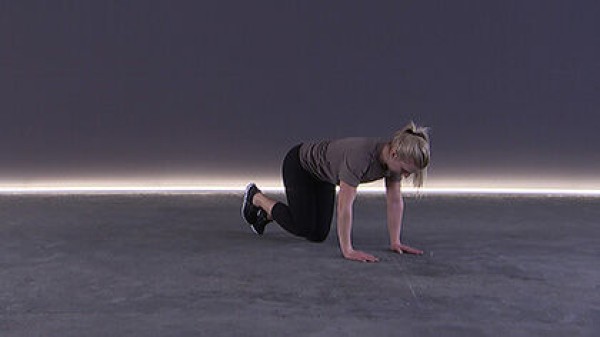

Four-foot stance (face/look down), bend one leg (right) and hold it up (right angle in the knee, lower leg perpendicular to the floor, sole of the foot pointing upwards), lower the training leg (right) (bring the knee towards the floor) and lift it back to the starting position (one-sided hip extension).
Attention:
Initiate the movement from the buttocks, pull in the abdomen, do not press into a hollow back and tense the gluteal muscles. Raise your leg to the maximum horizontal position.
Lighten:
Just hold the position with your leg raised; raise your leg less.
Harden:
Additional weight for the training leg.
1 weight cuff ► Make the exercise more difficult (additional weight)
Raising and lowering the leg in a four-footed stance (right) ► kick-back
Power
Individual work
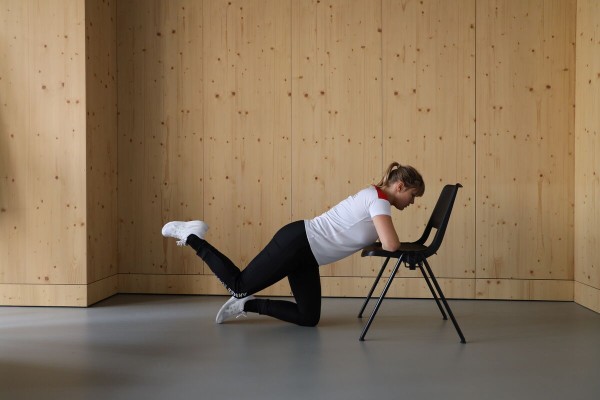
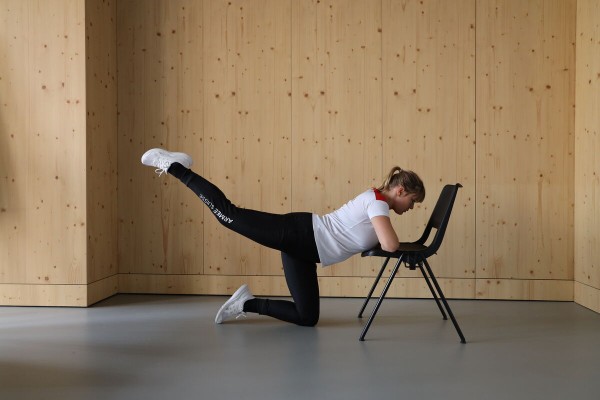
Stand on four feet (face/gaze downwards), support your upper body on the seat of the chair with your arms crossed (forearms resting on the seat cushion). Raise the free leg (right) and push it backwards. Then bend the leg again and bring the knee back to the starting position (if necessary, do not lower it completely).
Attention:
Trigger the movement from the buttocks, pull in the abdomen, do not press into the hollow back and tense the gluteal muscles.
1 (office) chair
Raising and lowering the leg in a four-footed stance (right) ► kick-back
Power
Individual work
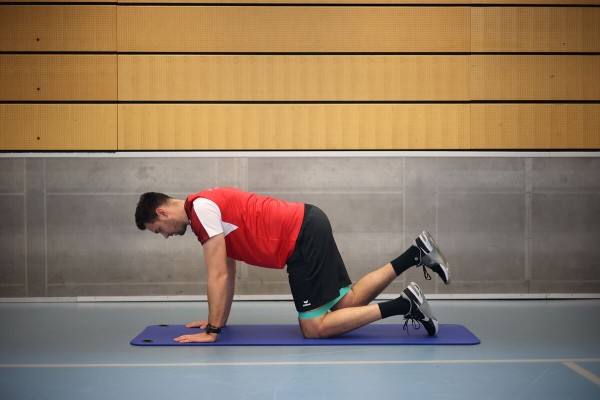
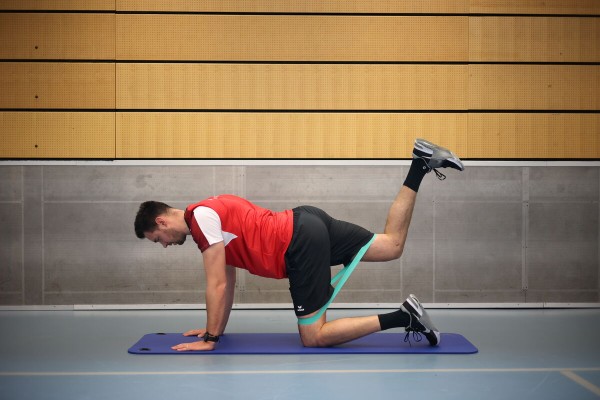
Four-foot stance (face/look down), bend one leg (right) and hold it up (right angle in the knee, thigh parallel and lower leg practically perpendicular to the floor, sole of the foot pointing upwards), lower the training leg (right) (bring the knee towards the floor) and lift it back to the starting position (one-sided hip extension).
Attention:
Initiate the movement from the buttocks, pull in the abdomen, do not press into a hollow back and tense the gluteal muscles. Raise your leg to the maximum horizontal position.
Lighten:
Select a rubber band with less resistance.
Harden:
Select a rubber band with greater resistance.
1 mini-band
Raising and lowering the leg in a four-footed stance (right) ► kick-back
Power
Individual work
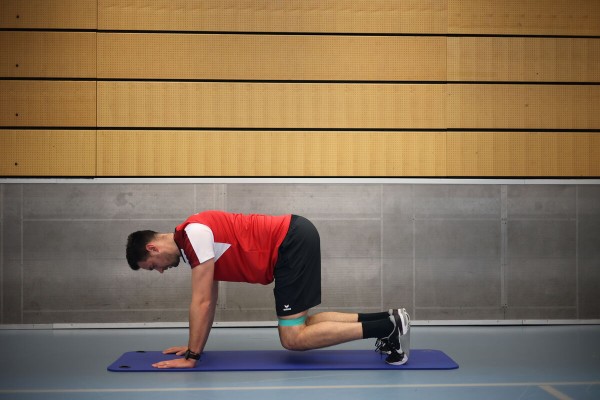
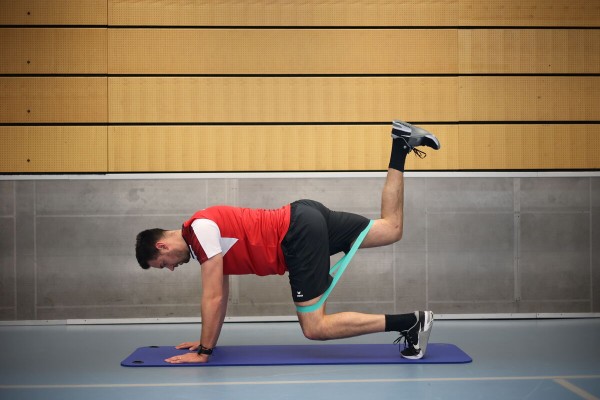
Four-foot stance (face/gaze downwards), with both legs slightly raised off the floor (right angle in the knee joint, thigh vertical and lower leg parallel to the floor, knee close to the floor), stretch an elasticated band between the legs (place the band around the thighs slightly above the knees). From this position, raise the training leg (right) (one-sided hip extension), leaving the position of the leg (angle in the knee joint) practically unchanged. In the end position, the sole of the foot points upwards, the lower leg is vertical and the thigh is parallel to the floor. Then lower the training leg back to the starting position.
Attention:
Initiate the movement from the buttocks, pull in the abdomen, do not press into a hollow back and tense the gluteal muscles. Raise your leg to the maximum horizontal position.
Lighten:
Choose a rubber band with less resistance.
Harden:
Choose a rubber band with greater resistance.
1 mini-band